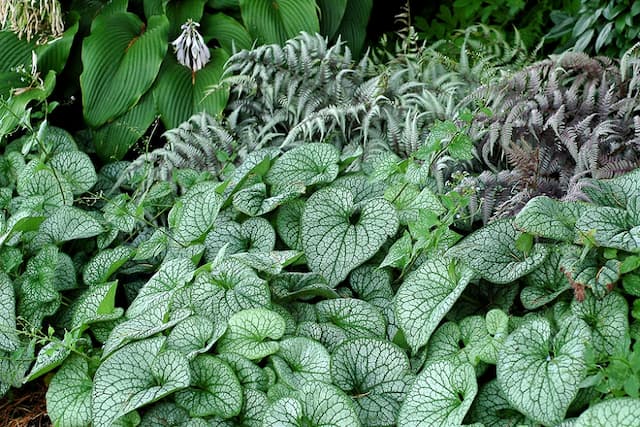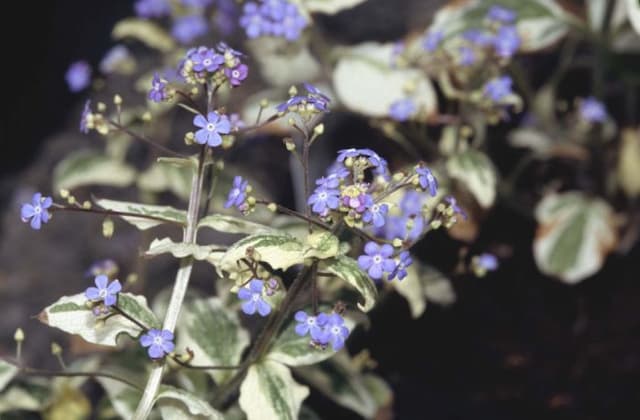Turkish Navelwort Omphalodes cappadocica

ABOUT
The plant known by its common name is commonly featured in gardens for its decorative appeal. Its notable feature is the profusion of delicate, star-shaped flowers colored in an enchanting shade of blue, resembling a forget-me-not. The flowers are centered with a bright white to pale yellow eye that adds a striking contrast against the petal color, creating a captivating visual effect in a garden setting. The foliage of this plant is rich green and has a lush, hairy texture, which forms a low-lying mound or a carpet-like spread over the ground it inhabits. These leaves are typically oval to heart-shaped and have a soft, almost velvety feel to the touch, contributing to the plant's overall soft appearance. As a whole, the plant presents itself as a charming addition to any space it occupies, creating a delightful tapestry of color when in bloom. The display of flowers emerges in the spring, setting the stage for a season of beauty. Despite its ornamental qualities, the description retains its focus on the appearance without discussing the size dimensions of this enchanting botanical specimen.
About this plant
 Names
NamesFamily
Boraginaceae.
Synonyms
Cappadocian Navelwort, Creeping Forget-Me-Not.
Common names
Cynoglossum omphalodes, Omphalodes linifolia, Omphalodes verna var. cappadocica, Omphalodes scorpioides.
 Toxicity
ToxicityTo humans
There is limited information available on the toxicity of Omphalodes cappadocica, commonly known as Navelwort, to humans. It is not commonly recognized as a toxic plant; however, plants not widely recognized as being poisonous could still cause mild stomach upset or an allergic reaction in sensitive individuals. If any part of the plant were to be ingested and symptoms appeared, medical attention should be sought.
To pets
There is limited information on the toxicity of Omphalodes cappadocica, known as Navelwort, to pets. Like in humans, this plant is not widely recognized as a toxic species to animals. However, different pets might react differently to ingesting plants. If a pet consumes Navelwort and shows signs of distress, such as vomiting, diarrhea, or unusual behavior, it is important to consult a veterinarian.
 Characteristics
CharacteristicsLife cycle
Perennials
Foliage type
Semi-deciduous
Color of leaves
Green
Flower color
Blue
Height
1 foot (30 cm)
Spread
1 foot (30 cm)
Plant type
Herb
Hardiness zones
4
Native area
Turkey
Benefits
 General Benefits
General Benefits- Aesthetic Appeal: Omphalodes cappadocica, commonly known as Navy-blue omphalodes, adds visual interest to gardens with its bright blue flowers and lush green foliage.
- Low Maintenance: Navy-blue omphalodes is recognized for being easy to care for, requiring minimal maintenance once established.
- Ground Cover: The plant's spreading habit makes it an excellent ground cover, helping to suppress weeds and protect soil from erosion.
- Attracts Pollinators: The flowers of the Navy-blue omphalodes attract bees and butterflies, which are beneficial for pollination of gardens.
- Seasonal Interest: With its spring bloom, Navy-blue omphalodes provides a welcome splash of color after winter, offering early seasonal interest.
- Shade Tolerance: This plant is suitable for shaded areas where many other flowering plants might not thrive, making it versatile for different garden situations.
- Companion Planting: Its low height and spreading nature make it good for filling gaps and serving as a backdrop for taller plants, enhancing overall garden design.
 Medical Properties
Medical Properties- This plant is not used for medical purposes.
 Air-purifying Qualities
Air-purifying QualitiesThis plant is not specifically known for air purifying qualities.
 Other Uses
Other Uses- Omphalodes cappadocica, commonly known as navelwort, can be used as a blue dye source for textiles, the blue flowers providing the color.
- In shade gardens, navelwort is often planted as a ground-cover plant, due to its low-growing habit and attractive foliage.
- Navelwort works well in rock gardens for its ability to thrive in the nooks and crannies of rocky terrain, giving a naturalistic appearance.
- The plant is suitable for planting under trees and shrubs, where other plants might struggle with the dappled light and root competition.
- Navelwort's dense mat of leaves can provide erosion control on slopes or areas where grass might not grow as well.
- It can be used in a cottage garden design for creating a 'wild' look with its informal growth habit and delicate blue flowers.
- In a wildlife garden, navelwort's flowers attract pollinators like bees and butterflies, enhancing biodiversity.
- For educational purposes, navelwort can be used to teach children or gardening enthusiasts about native plant species and their habitats.
- This plant can be included in sensory gardens, as its soft foliage provides a contrast in texture for tactile exploration.
- Navelwort can be presented in floral arrangements, especially when seeking a natural and rustic look, as the delicate flowers add a subtle charm.
Interesting Facts
 Feng Shui
Feng ShuiThe Omphalodes cappadocica, also known as navelwort, is not used in Feng Shui practice.
 Zodiac Sign Compitability
Zodiac Sign CompitabilityThe navelwort is not used in astrology practice.
 Plant Symbolism
Plant Symbolism- Resilience: The Omphalodes cappadocica, commonly known as Cappadocian navelwort, often thrives in challenging conditions, representing the ability to endure and prosper despite adversity.
- Hope: As it blooms early in spring, the Cappadocian navelwort symbolizes hope and the promise of new beginnings, suggesting optimism for the future.
- Perseverance: Cappadocian navelwort's habit of growing and spreading can represent one's persistence in overcoming obstacles through constant effort.
 Water
WaterNavelwort (Omphalodes cappadocica) prefers consistently moist soil but is not tolerant of waterlogged conditions. It is best to water it thoroughly when the top inch of the soil feels dry to the touch. Generally, this means watering approximately once a week, but this can vary depending on the climate and indoor conditions. Use lukewarm water and add slowly until you notice a bit of excess water beginning to drain from the bottom of the pot. Over the course of a month, you might end up using about 1 to 2 gallons of water, adjusted to the plant's response and the season, with less water needed in the winter months.
 Light
LightNavelwort thrives in conditions with partial shade to full shade, avoiding direct, strong sunlight that can damage the foliage. The best spot for this plant would be in a location where it receives filtered light or a few hours of morning sun followed by shade for the remainder of the day. An ideal lighting condition is a north-facing window or a spot under a tree that provides dappled sunlight.
 Temperature
TemperatureNavelwort does well in a wide range of temperatures but prefers a cooler environment. The ideal temperature range for Omphalodes cappadocica is between 50 to 70 degrees Fahrenheit. It can survive minimum temperatures down to 30 degrees Fahrenheit for short periods and should not be exposed to temperatures over 80 degrees Fahrenheit for extended periods as this can cause heat stress.
 Pruning
PruningNavelwort does not require extensive pruning. Trimming may be done to remove any dead or damaged leaves and to maintain its shape. The best time to prune Omphalodes cappadocica is in early spring or after it flowers, which allows the plant to direct its energy to new growth. Pruning once a year is generally sufficient to keep the plant tidy and healthy.
 Cleaning
CleaningAs needed
 Soil
SoilNavelwort thrives in moisture-retentive, well-draining soil with high organic matter. A mix of loam, peat, and sharp sand in equal parts is ideal. The pH should be slightly acidic to neutral, ranging from 6.0 to 7.0, for optimal growth.
 Repotting
RepottingNavelwort does not require frequent repotting and can be done every 2-3 years or when the plant outgrows its current container. Ensure the new pot is only slightly larger than the previous one to avoid excess soil moisture.
 Humidity & Misting
Humidity & MistingNavelwort prefers a moderately humid environment, with a relative humidity level of around 50% being ideal. It can tolerate some fluctuations, but extreme dryness should be avoided.
 Suitable locations
Suitable locationsIndoor
Place Navelwort in bright, indirect light with moist soil.
Outdoor
Grow Navelwort in shade, with moist soil and shelter from wind.
Hardiness zone
4-9 USDA
 Life cycle
Life cycleOmphalodes cappadocica, commonly known as Cappadocian Navelwort, begins its life cycle as a seed that germinates in spring when soil temperatures are suitable. After germination, seedlings establish themselves, developing a rosette of leaves close to the ground. As the plant matures, it sends up flowering stalks, with small blue, bell-shaped flowers that usually bloom in late spring to early summer. Pollination occurs through the activity of insects, resulting in the production of small nutlets that serve as the plant’s seeds. Once the flowering period is over, the plant will produce these seeds which are then dispersed, often by wind, to begin a new generation. The plant is perennial, thus after the seeds are shed, the plant will survive through its root system and regrow the following year, repeating its life cycle.
 Propogation
PropogationPropogation time
Spring-Early Summer
Omphalodes cappadocica, also known as the Cappadocian navelwort, is typically propagated by seed. The most popular method involves sowing the seeds in spring, once the threat of frost has passed. To propagate, seeds should be scattered over the surface of a well-draining soil mix and lightly covered with additional soil. These seeds require light to germinate, so the covering should be minimal. The soil must be kept moist but not waterlogged, and the container should be placed in a warm spot with indirect light. Germination can be erratic, so patience is a virtue with this method. Seedlings will emerge and can be transplanted to their final location once they have developed a set of true leaves and are large enough to handle.









